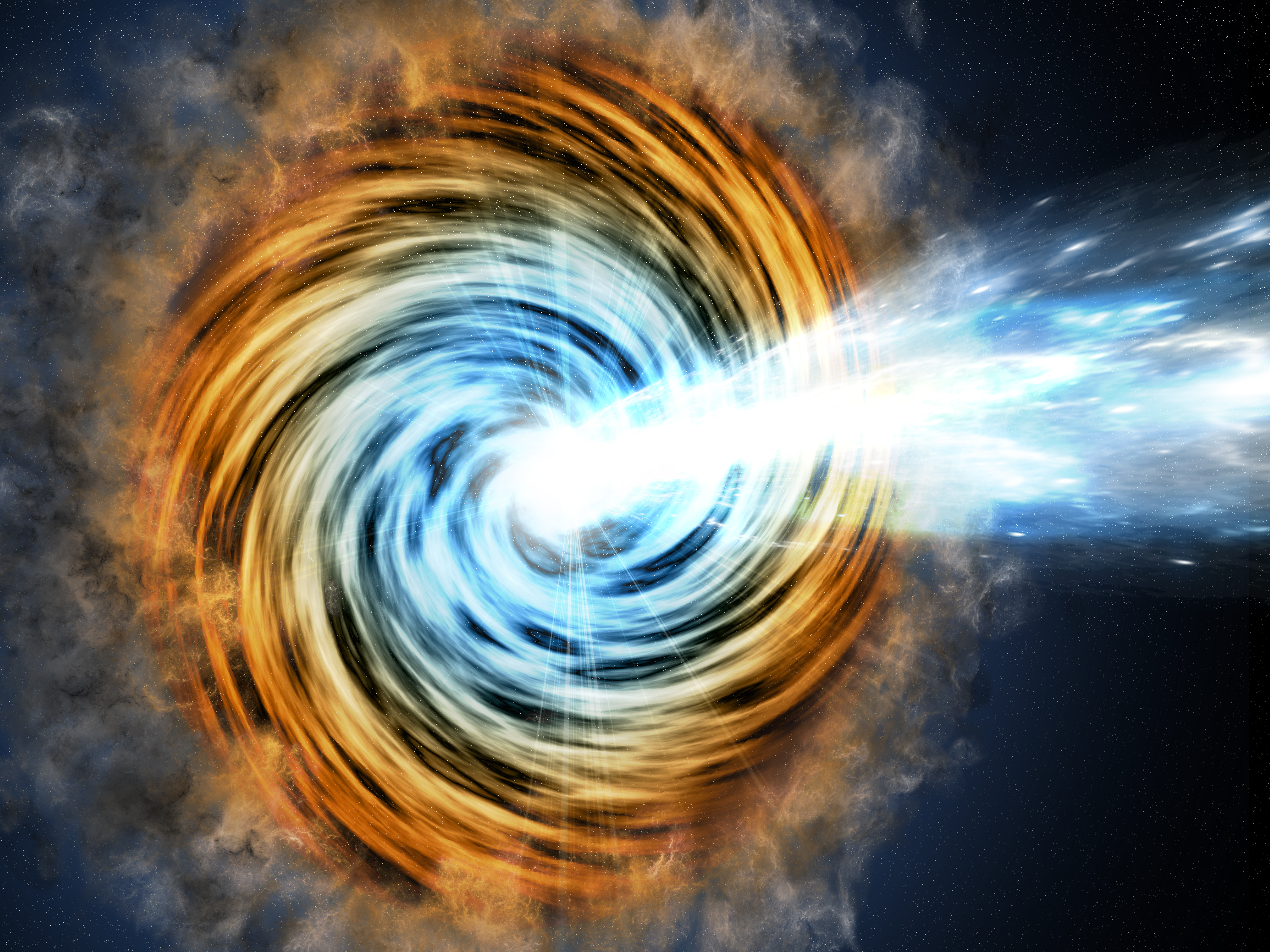Universe
ID: 12454
NASA's Fermi Gamma-ray Space Telescope has identified the farthest gamma-ray blazars, a type of galaxy whose intense emissions are powered by supersized black holes. Light from the most distant object began its journey to us when the universe was 1.4 billion years old, or nearly 10 percent of its present age.
Despite their youth, these far-flung blazars host some of the most massive black holes known. That they developed so early in cosmic history challenges current ideas of how supermassive black holes form and grow.
Blazars constitute roughly half of the gamma-ray sources detected by Fermi's Large Area Telescope (LAT). Astronomers think their high-energy emissions are powered by matter heated and torn apart as it falls from a storage, or accretion, disk toward a supermassive black hole with a million or more times the sun's mass. A small part of this infalling material becomes redirected into a pair of particle jets, which blast outward in opposite directions at nearly the speed of light. Blazars appear bright in all forms of light, including gamma rays, the highest-energy light, when one of the jets happens to point almost directly toward us.
Previously, the most distant blazars detected by Fermi emitted their light when the universe was about 2.1 billion years old. Earlier observations showed that the most distant blazars produce most of their light at energies right in between the range detected by the LAT and current X-ray satellites, which made finding them extremely difficult.
Then, in 2015, the Fermi team released a full reprocessing of all LAT data, called Pass 8, that ushered in so many improvements astronomers said it was like having a brand new instrument. The LAT's boosted sensitivity at lower energies increased the chances of discovering more far-off blazars.
Two of the blazars boast black holes of a billion solar masses or more. All of the objects possess extremely luminous accretion disks that emit more than two trillion times the energy output of our sun. This means matter is continuously falling inward, corralled into a disk and heated before making the final plunge to the black hole.

Fermi Finds the Farthest Blazars
Despite their youth, these far-flung blazars host some of the most massive black holes known. That they developed so early in cosmic history challenges current ideas of how supermassive black holes form and grow.
Blazars constitute roughly half of the gamma-ray sources detected by Fermi's Large Area Telescope (LAT). Astronomers think their high-energy emissions are powered by matter heated and torn apart as it falls from a storage, or accretion, disk toward a supermassive black hole with a million or more times the sun's mass. A small part of this infalling material becomes redirected into a pair of particle jets, which blast outward in opposite directions at nearly the speed of light. Blazars appear bright in all forms of light, including gamma rays, the highest-energy light, when one of the jets happens to point almost directly toward us.
Previously, the most distant blazars detected by Fermi emitted their light when the universe was about 2.1 billion years old. Earlier observations showed that the most distant blazars produce most of their light at energies right in between the range detected by the LAT and current X-ray satellites, which made finding them extremely difficult.
Then, in 2015, the Fermi team released a full reprocessing of all LAT data, called Pass 8, that ushered in so many improvements astronomers said it was like having a brand new instrument. The LAT's boosted sensitivity at lower energies increased the chances of discovering more far-off blazars.
Two of the blazars boast black holes of a billion solar masses or more. All of the objects possess extremely luminous accretion disks that emit more than two trillion times the energy output of our sun. This means matter is continuously falling inward, corralled into a disk and heated before making the final plunge to the black hole.

For More Information
Credits
Francis Reddy (Syneren Technologies): Lead Science Writer
Scott Wiessinger (USRA): Lead Producer
Scott Wiessinger (USRA): Animator
Erin McKinley (OSU): Narrator
Francis Reddy (University of Maryland College Park): Visualizer
Scott Wiessinger (USRA): Lead Producer
Scott Wiessinger (USRA): Animator
Erin McKinley (OSU): Narrator
Francis Reddy (University of Maryland College Park): Visualizer
Please give credit for this item to:
NASA's Goddard Space Flight Center. However, individual items should be credited as indicated above.
NASA's Goddard Space Flight Center. However, individual items should be credited as indicated above.
Short URL to share this page:
https://svs.gsfc.nasa.gov/12454
Mission:
Fermi Gamma-ray Space Telescope
This item is part of these series:
Narrated Movies
Astrophysics Stills
Astrophysics Features
Keywords:
SVS >> Galaxy
SVS >> HDTV
SVS >> Music
GCMD >> Earth Science >> Spectral/Engineering >> Gamma Ray
SVS >> Black Hole
SVS >> Astrophysics
SVS >> Edited Feature
SVS >> Space
SVS >> Fermi
DLESE >> Narrated
SVS >> Blazar
NASA Science >> Universe
GCMD keywords can be found on the Internet with the following citation: Olsen, L.M., G. Major, K. Shein, J. Scialdone, S. Ritz, T. Stevens, M. Morahan, A. Aleman, R. Vogel, S. Leicester, H. Weir, M. Meaux, S. Grebas, C.Solomon, M. Holland, T. Northcutt, R. A. Restrepo, R. Bilodeau, 2013. NASA/Global Change Master Directory (GCMD) Earth Science Keywords. Version 8.0.0.0.0
https://svs.gsfc.nasa.gov/12454
Mission:
Fermi Gamma-ray Space Telescope
This item is part of these series:
Narrated Movies
Astrophysics Stills
Astrophysics Features
Keywords:
SVS >> Galaxy
SVS >> HDTV
SVS >> Music
GCMD >> Earth Science >> Spectral/Engineering >> Gamma Ray
SVS >> Black Hole
SVS >> Astrophysics
SVS >> Edited Feature
SVS >> Space
SVS >> Fermi
DLESE >> Narrated
SVS >> Blazar
NASA Science >> Universe
GCMD keywords can be found on the Internet with the following citation: Olsen, L.M., G. Major, K. Shein, J. Scialdone, S. Ritz, T. Stevens, M. Morahan, A. Aleman, R. Vogel, S. Leicester, H. Weir, M. Meaux, S. Grebas, C.Solomon, M. Holland, T. Northcutt, R. A. Restrepo, R. Bilodeau, 2013. NASA/Global Change Master Directory (GCMD) Earth Science Keywords. Version 8.0.0.0.0











